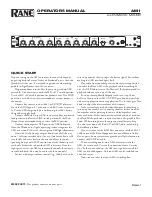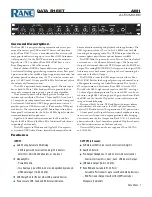
Processor Types
153
03D—Owner’s Manual
THRESHOLD
—This determines the level at which the gate closes, cutting off the sig-
nal. Signals above the threshold level pass through unaffected. Signals at or below the
threshold, however, cause the gate to close. The trigger signal is sourced using the KEY
IN parameter.
RANGE
—This determines the level to which the gate closes. Think of it as a brick hold-
ing a garden gate open so that a certain amount of signal always flows through. For a
setting of –70 dB, the gate closes completely when the input signal falls below the
threshold. For a setting of –30 dB, however, the gate only closes so far. For a setting of
0 dB, the gate has no effect. When signals are gated abruptly, the sudden disappearance
can sometimes sound odd. This parameter causes the gate to reduce the signal level
rather than cut it completely.
ATTACK
—This determines how fast the gate opens when the signal exceeds the thresh-
old level. Slow attack times can be used to remove the initial transient edge of percussive
sounds. Too slow an attack time makes some sounds appear backwards.
HOLD
—This determines how long the gate stays open once the trigger signal has fallen
below the threshold level.
DECAY
—This determines how fast the gate closes once the hold time has expired. A
longer decay time produces a more natural gating effect, allowing the natural decay of
an instrument to pass through. With a maximum decay time of between 42 and 63 sec-
onds, you could even use this for fade-outs.
DUCKING
Ducking is commonly used for voice-over appli-
cations, where the background music level is
reduced automatically when an announcer
speaks. Ducking is achieved by triggering a com-
pressor with a different sound source. For exam-
ple, a ducker is patched into the background
music channel, and the KEY IN signal is sourced
from the announcer’s microphone channel.
When the announcer’s microphone level exceeds
the specified threshold, the background music
level is reduced automatically, allowing the
announcer to be heard clearly. The same tech-
nique can also be used for vocals in a mix. For example, ducking backing sounds such
as rhythm guitar and synth pad during vocal phrases allows the vocals to be heard
clearly. This can also be used to bring solo instruments up in a mix.
THRESHOLD
—This determines the level of trigger signal (KEY IN) required to acti-
vate ducking. Trigger signal levels below the threshold do not activate ducking. Trigger
signals at and above the threshold level, however, activate ducking, and the signal level
Parameter
Range
THRESHOLD
–54 dB to 0 dB (55 steps)
RANGE
–70 dB to 0 dB (71 steps)
ATTACK
0–120 ms (1 ms steps)
HOLD
0.02 ms–1.96 s (sampling rate @ 48 kHz)
0.02 ms–2.13 s (sampling rate @ 44.1 kHz)
0.03 ms–2.94 s (sampling rate @ 32 kHz)
DECAY
5 ms–42.3 s (sampling rate @ 48 kHz)
6 ms–46 s (sampling rate @ 44.1 kHz)
8 ms–63.4 s (sampling rate @ 32 kHz)
–70
–60
–50
–40
–30
–20
–10
0
+10
+20
–70
–60
–50
–40
–30
–20
–10
0
+10
+20
Input Level (dB)
Output Level (dB)
Range = –30dB
Threshold = –20dB















































